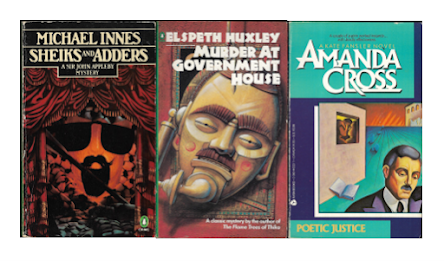Murder & Other Acts of Literature: Twenty-Four Unforgettable & Chilling Stories by Some of the World's Best-Loved, Most Celebrated Writers (1997) by Michele Slung, ed.Not your usual murder mystery collection--not least because none of the authors included are known for their crime fiction. Slung has put together a collection of "crime" stories by authors more comfortable on the fiction shelves than in they mystery section. And, honestly, it shows. There are few genuine mysteries here--Paul Theroux comes closest with A. A. Milne of Winnie-the-Pooh fame a close second. Nearly all of the other stories are more concerned with examining social conventions or personal relationships or psychological consequences than they are with the actual crime or the detection thereof. So, if you're looking for mystery puzzles, these stories are not for you. And, mostly, they're not for me, either. The writing is excellent, as one would expect from writers of this caliber. The themes are interesting. But this is definitely not what I'm looking for when I sit down for a good mystery. The best of the bunch are the previously mentioned Theroux and Milne stories ("The Johore Murders" and In Vino Veritas"). I also recommend "By a Person Unknown," "The Widow & the Parrot: A True Story," and "The Portobello Road." ★★★
"Montraldo" by John Cheever: A man steals a diamond ring from Tiffany's and uses the proceeds to go to Italy. There he witnesses a strange relationship between an elderly Italian woman and her servant--who is emboldened to treat her badly. [one fell & hit head]
"The Hitch-Hikers" by Eudora Welty: A traveling salesman by the name of Harris picks up two hitchhikers--one of which has a guitar. The two try to steal his car and one winds up dead.[one hit on head]
"Success or Failure" by T. H. White: A childless couple imagine themselves a son. But when their fantasies take an unexpected turn, the proud father can't bear what his wife has imagined. [one hit on head]
"By a Person Unknown" by Naguib Mahfouz: Police office Muhsin feels his reputation is at stake when a killer repeatedly gets away with murder--strangling people indiscriminately and leaving no clues behind. But he should be worried about more than his reputation. [many strangled--but only 2 named]
"How Did I Get Away With Killing One of the Biggest Lawyers in the State? It Was Easy." by Alice Walker: A young black woman tells how she got away with shooting the lawyer who seduced her. [one shot]
"The Hotel of the Idle Moon" by William Trevor: A couple looking for an easy target impose themselves on the elderly Sir Giles Marston, his wife, and elderly butler. Soon they've taken over the place. [2 natural--apparently]
"Aaron Trowe" by Anthony Trollope: Aaron Trowe was a convicted killer in Bermuda who managed to break jail and escape capture (even though he never left the island). But then he messes with the wrong woman...[one drowned]
"The Fat Man" by Isak Dinesen: A young girl is murdered and the only clue to her killer is the fact that she was last seen in the company of a fat man. A college student who moonlights as a bartender comes up with a plan to find out if one of the regulars in the bar is the fat man in question.
"Mr. Loveday's Outing" by Evelyn Waugh: A young woman visits her father, an inmate at an asylum, and takes pity on the fellow inmate who is serving as her father's secretary. He seems to be completely cured and so she lobbies to have him released. There's something he's wanted to to do ever since he was sent to the asylum--and as soon as he does it, he comes right back.
"The Johore Murders" by Paul Theroux: The closest to a traditional mystery story to be found in this collection. An embassy official gets to the bottom of the murders of two expatriots--one British and one American--when the local Malaysian police can't.[2 stabbed]
"A Journey" by Edith Wharton: A young woman is traveling home by train with her terminally ill husband. But will they both make it to the last stop?
"Miss Forbes' Summer of Happiness" by Gabriel García Márquez: Two young boys are left in the charge of a strict German governess. But they soon learn that she holds herself to a much lower standard and they plot to poison her. But someone else beats them to it. [one stabbed]
"The Macbeth Murder Mystery" by James Thurber: Just read this in the last collection--so here's an encore. A crime fiction fiend mistakenly picks up Shakespeare's Macbeth and decides that William has pulled the wool over his audience's eyes. She knows who really killed the king. [2 stabbed]
"A Double Tragedy: An Actor's Story" by Louisa May Alcott: A story of jealousy and revenge among the Shakespearean actors who play star-crossed lovers. [one fell from height; one stabbed]
"Un Crime Maternel" by Fay Weldon: A woman tries to convince the psychiatrist sent to evaluate her mental competency that she is neither insane nor truly guilty of the crime of murder. [one poisoned]
"Mary Postgate" by Rudyard Kipling: Mary Postgate, always thought to be like Winnie-the-Pooh (a bear with little brain), manages to do her bit for the World War I homefront. [one airplane crash]
"The Walker" by Patrick O'Brien: A man plays avenging angel in the murder of a priest. [two fell from height]
"Country Lovers" by Nadine Gordimer: A young black girl and a young white boy grow up together in South Africa during apartheid. Tragedy strikes when she becomes pregnant and marries someone else. [one beaten]
"Monk" by William Faulkner: Our narrator tries to piece together the life and death of the man named Monk, who went to prison for murder. [two natural; one hanged; two shot]
"The Widow & the Parrot: A True Story" by Virginia Woolf: The poor Mrs. Gage inherits a cottage and a parrot named James from her miserly brother. She learns that it pays to be kind to animals. [three natural]
"My Maiden Brief" by W. S. Gilbert: A humorous look at our narrator's first, last, and only brief as a solicitor at the Old Bailey.
"An Act of Vengeance" by Isabelle Allende: A lesson in vengeance--be careful when vowing to avenge someone. It may lead to your own destruction. [one crushed by horses; one shot; one stabbed]
"In Vino Veritas" by A. A. Milne: A writer of mystery stories and his friend, a police inspector find themselves discussing what seemed to be the perfect murder by poison. But is the murderer finished? [two poisoned; one hit by underground train]
"The Portobello Road" by Muriel Spark: A ghost story told by the ghost herself. A group of four friends who grew up together go there separate ways, despite one of them insisting that they "must stick together." Our narrator is entrusted with a secret--but when she decides that she can't keep it any longer, she's killed. She haunts her killer on the Portobello Road. (one suffocated)
First line (1st story): The first time I robbed Tiffany's it was raining.
Last line (last story): For my part, I consider it quite a jolly snap, but I don't think we were any of us so lovely as we look in it, gazing blatantly over the ripe cornfields, Skinny with his humorous expression, I secure in my difference from the rest, Kathleen with her head prettily perched on her hands, each reflecting fearlessly in the face of George's camera the glory of the world, as if it would never pass.









.jpg)














.jpg)
.jpg)
.jpg)
.jpg)

.jpg)
.jpg)
.jpg)
.jpg)



.jpg)



















